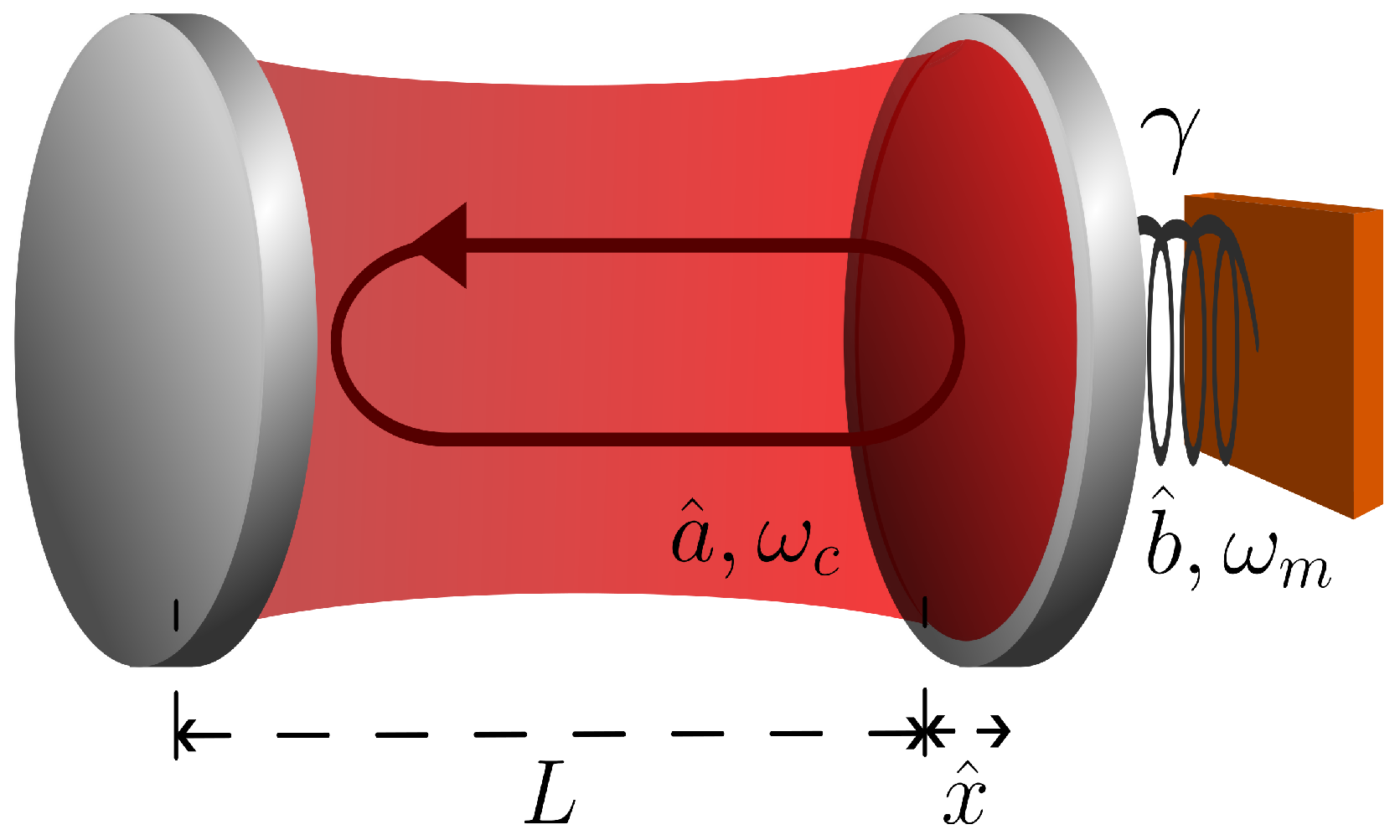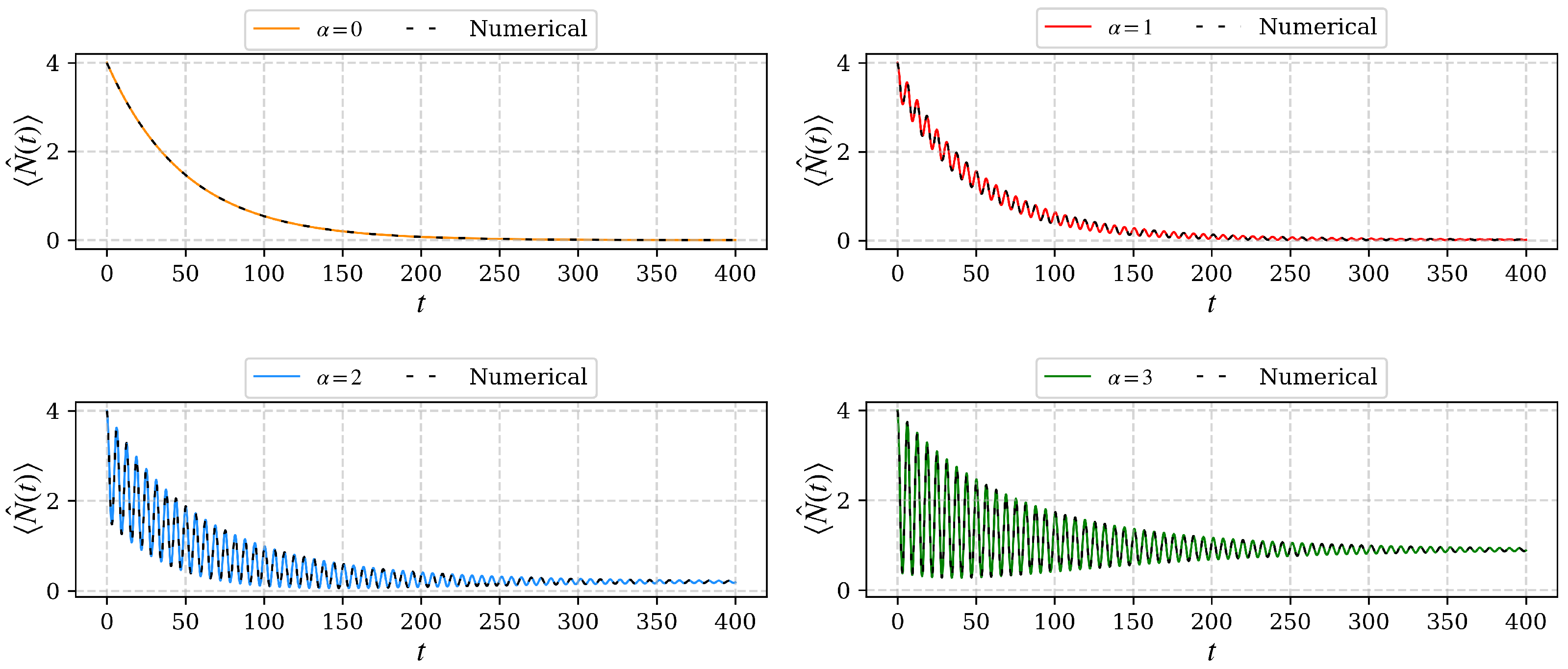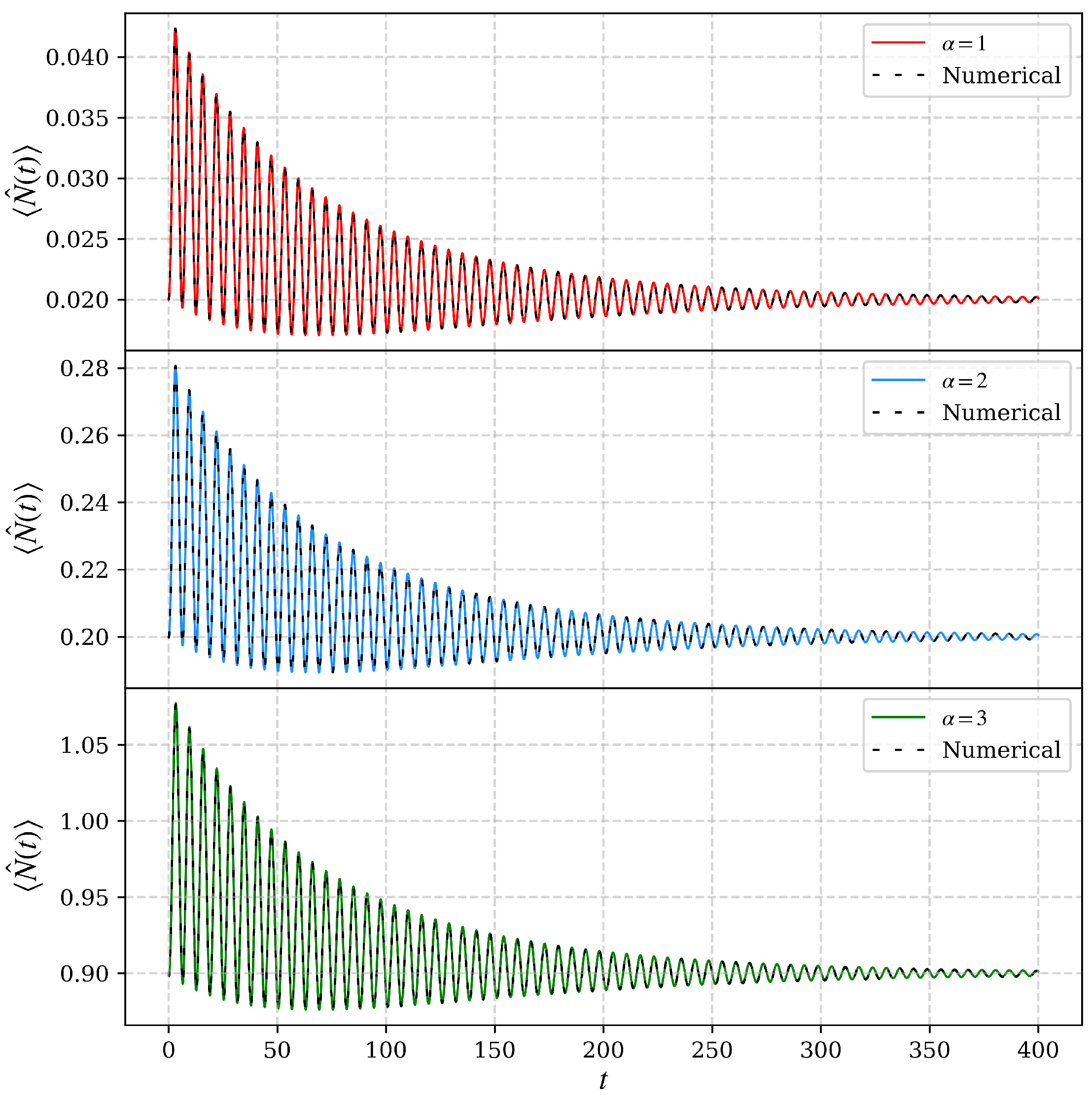Superoperator Approach to the Lindbladian Dynamics of a Mirror-Field System
Abstract
1. Introduction
2. The Basic Optomechanical System
3. Optomechanical System with Damping in the Mechanical Oscillator
3.1. Obtaining the Standard Hamiltonian in the Optomechanical Master Equation
3.2. Analytical Solution: Damping of the Mechanical Oscillator
3.3. Coherent States as Initial Conditions
3.4. Steady State
4. Conclusions
Author Contributions
Funding
Data Availability Statement
Acknowledgments
Conflicts of Interest
References
- Aspelmeyer, M.; Meystre, P.; Schwab, K. Quantum optomechanics. Phys. Today 2012, 65, 29–35. [Google Scholar] [CrossRef]
- Meystre, P. A short walk through quantum optomechanics. Ann. Der Phys. 2013, 525, 215–233. [Google Scholar] [CrossRef]
- Bowen, W.P.; Milburn, G.J. Quantum Optomechanics; CRC Press: Boca Raton, FL, USA, 2015. [Google Scholar]
- Aspelmeyer, M.; Kippenberg, T.J.; Marquardt, F. Cavity optomechanics. Rev. Mod. Phys. 2014, 86, 1391–1452. [Google Scholar]
- Marquardt, F.; Girvin, S.M. Optomechanics. Physics 2009, 2, 40. [Google Scholar] [CrossRef]
- Metcalfe, M. Applications of cavity optomechanics. Appl. Phys. Rev. 2014, 1, 031105. [Google Scholar]
- Schliesser, A.; Rivière, R.; Anetsberger, G.; Arcizet, O.; Kippenberg, T.J. Resolved-sideband cooling of a micromechanical oscillator. Nat. Phys. 2008, 4, 415–419. [Google Scholar]
- Chan, J.; Alegre, T.P.M.; Safavi-Naeini, A.H.; Hill, J.T.; Krause, A.; Gröblacher, S.; Aspelmeyer, M.; Painter, O. Laser cooling of a nanomechanical oscillator into its quantum ground state. Nature 2011, 478, 89–92. [Google Scholar] [PubMed]
- Brooks, D.W.; Botter, T.; Schreppler, S.; Purdy, T.P.; Brahms, N.; Stamper-Kurn, D.M. Non-classical light generated by quantum-noise-driven cavity optomechanics. Nature 2012, 488, 476–480. [Google Scholar] [PubMed]
- Teufel, J.D.; Donner, T.; Castellanos-Beltran, M.A.; Harlow, J.W.; Lehnert, K.W. Nanomechanical motion measured with an imprecision below that at the standard quantum limit. Nat. Nanotechnol. 2009, 4, 820–823. [Google Scholar] [CrossRef] [PubMed]
- Bemani, F.; Roknizadeh, R.; Naderi, M.H. Theoretical scheme for the realization of the sphere-coherent motional states in an atom-assisted optomechanical cavity. J. Opt. Soc. Am. B 2015, 32, 1360–1368. [Google Scholar] [CrossRef]
- Mancini, S.; Man’Ko, V.I.; Tombesi, P. Ponderomotive control of quantum macroscopic coherence. Phys. Rev. A 1997, 55, 3042. [Google Scholar] [CrossRef]
- Bose, S.; Jacobs, K.; Knight, P.L. Preparation of nonclassical states in cavities with a moving mirror. Phys. Rev. A 1997, 56, 4175. [Google Scholar]
- Ventura-Velázquez, C.; Rodríguez-Lara, B.M.; Moya-Cessa, H.M. Operator approach to quantum optomechanics. Phys. Scr. 2015, 90, 068010. [Google Scholar] [CrossRef]
- Arévalo-Aguilar, L.M.; Moya-Cessa, H.M. Cavidad con pérdidas: Una descripción usando superoperadores. Rev. Mex. Física 1995, 42, 675–683. [Google Scholar]
- Phoenix, S.J. Wave-packet evolution in the damped oscillator. Phys. Rev. A 1990, 41, 5132. [Google Scholar]
- Law, C.K. Interaction between a moving mirror and radiation pressure: A Hamiltonian formulation. Phys. Rev. A 1995, 51, 2537. [Google Scholar] [CrossRef]
- Primo, A.G.; Pinho, P.V.; Benevides, R.; Gröblacher, S.; Wiederhecker, G.S.; Alegre, T.P.M. Dissipative Optomechanics in High-Frequency Nanomechanical Resonators. Nat. Commun. 2023, 14, 5793. [Google Scholar] [CrossRef]
- Mancini, S.; Tombesi, P. Quantum noise reduction by radiation pressure. Phys. Rev. A 1994, 49, 4055. [Google Scholar] [CrossRef] [PubMed]
- Glauber, R.J. Coherent and incoherent states of the radiation field. Phys. Rev. 1963, 131, 2766. [Google Scholar] [CrossRef]
- Medina-Dozal, L.; Récamier, J.; Moya-Cessa, H.M.; Soto-Eguibar, F.; Román-Ancheyta, R.; Ramos-Prieto, I.; Urzúa, A.R. Temporal evolution of a driven optomechanical system in the strong coupling regime. Phys. Scr. 2023, 99, 015114. [Google Scholar]
- Wei, J.; Norman, E. On global representations of the solutions of linear differential equations as a product of exponentials. Proc. Am. Math. Soc. 1964, 15, 327–334. [Google Scholar] [CrossRef]



Disclaimer/Publisher’s Note: The statements, opinions and data contained in all publications are solely those of the individual author(s) and contributor(s) and not of MDPI and/or the editor(s). MDPI and/or the editor(s) disclaim responsibility for any injury to people or property resulting from any ideas, methods, instructions or products referred to in the content. |
© 2025 by the authors. Licensee MDPI, Basel, Switzerland. This article is an open access article distributed under the terms and conditions of the Creative Commons Attribution (CC BY) license (https://creativecommons.org/licenses/by/4.0/).
Share and Cite
García-Márquez, M.A.; Moya-Cessa, H.M. Superoperator Approach to the Lindbladian Dynamics of a Mirror-Field System. Quantum Rep. 2025, 7, 15. https://doi.org/10.3390/quantum7020015
García-Márquez MA, Moya-Cessa HM. Superoperator Approach to the Lindbladian Dynamics of a Mirror-Field System. Quantum Reports. 2025; 7(2):15. https://doi.org/10.3390/quantum7020015
Chicago/Turabian StyleGarcía-Márquez, Marco A., and Héctor M. Moya-Cessa. 2025. "Superoperator Approach to the Lindbladian Dynamics of a Mirror-Field System" Quantum Reports 7, no. 2: 15. https://doi.org/10.3390/quantum7020015
APA StyleGarcía-Márquez, M. A., & Moya-Cessa, H. M. (2025). Superoperator Approach to the Lindbladian Dynamics of a Mirror-Field System. Quantum Reports, 7(2), 15. https://doi.org/10.3390/quantum7020015









